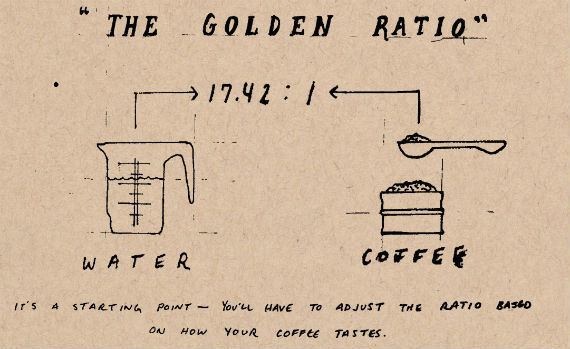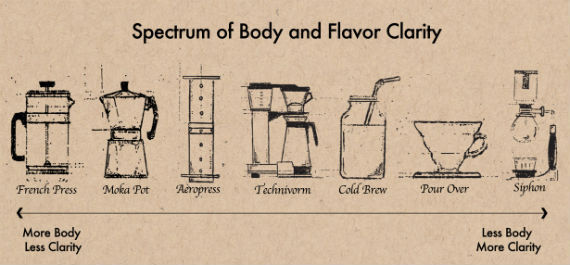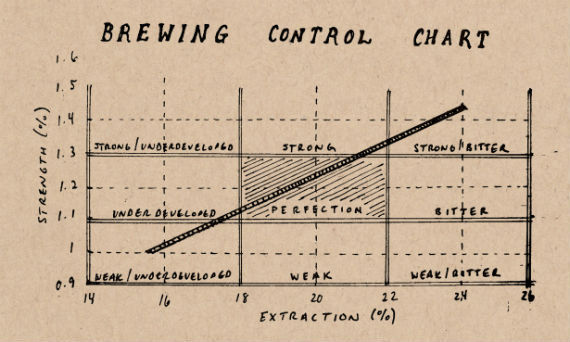Classical fine tuning method
When we were just beginning to get in touch with all this and were not familiar with coffee, it was a pity that no one could explain why the coffee made in the French filter press (Frenchpress) was so mellow, or why the pourover coffee had such a pure taste.
The answers to these questions are tried to hide. We only see the appearance of these puzzles and put the questions aside for the time being.
At last we found the answer to the question by chemical method. Chemically speaking, substances in the world are divided into two categories: soluble substances and insoluble substances. The soluble particles extracted from coffee powder produce the unique flavor and smell of coffee, while the main function of insoluble particles is to make coffee mellow.
Roasted coffee beans are made up of these two particles, so how to balance the two ingredients in the extraction process determines what your coffee will end up like.
Do you prefer coffee that is full-bodied and sandy? Try the French filter press. Looking for coffee with a pure taste that highlights the citrus flavor of South American coffee beans or the berry flavor of African coffee beans? Check out the coffee maker.
Everyone has their own preferences, but as long as you choose the brewing method, you can further fine-tune the coffee by adjusting these variables:
1. The grinding particle size of coffee beans: the grinding particle size affects the surface area of the particles, and then affects the extraction rate. Coarse ground coffee beans have a smaller surface area than the same amount of finely ground coffee beans, making it more difficult for water to penetrate or extract coffee solids.
Uniform grinding size means that the extraction rate of oil and acid in coffee is equal, so that there are no large particles that are not fully extracted or small particles that are overextracted. This is why coffee experts always advocate the purchase of a high-quality disc grinder. You know what? They're right.
two。 Water temperature: because when the temperature is higher, the solid dissolves faster, so the temperature affects the extraction rate. In addition, the temperature determines which solid dissolves, which in turn affects the taste. The high temperature of the water will make the coffee sour, because the high temperature will release the unpleasant acidity in the coffee beans.
Therefore, we recommend that you use water between 195 and 202 degrees Fahrenheit to make coffee. Remember, this refers to the actual temperature of the coffee, not the water temperature. There is usually a difference between the two.
3. The number of times you stir the coffee grounds during brewing: you can stir the coffee grounds as the water passes by to further control the brewing process. Stirring is useful because it increases the diffusion rate of dissolved coffee solids in water, allowing coffee grounds to come into contact with water more quickly.
But stirring also has the effect of lowering the water temperature, which we know will affect the cooking process. But at the end of the day, it's just a skill you can master over and over again.
4. The ratio of coffee to water: it's a little strange to come back to this point, isn't it?
But the key difference here is that when you mix coffee, you don't have to strictly follow the golden ratio. Instead, adjust it according to your own taste. To make deployment easier, buy a balance. The results of measuring the weight of coffee and water will be more accurate than measuring capacity.
Last point. A good barista will tell you to make sure to adjust only one variable at a time so that you can accurately observe the results. Adjusting two variables at a time will confuse the result, and you will not know whether you changed the X variable or the Y variable, causing the change of the result.
This is not a complex space science.
Although we talk a lot about chemical reactions, particles, molecules and extraction rates, making good coffee is not so much a science as an art. Once you have mastered the rules behind the cooking process, you can develop a method that works best for you.
That's the charm of coffee. When we first entered this field, we were so embarrassed that we knew nothing about most of the basic knowledge. The selection of materials, processing, and appliances are all coming, and we have no way to start at all.
But soon, we will find that we are climbing along the road of coffee study. You don't have to spend your whole life making good coffee. It is a hobby that we can practice and cultivate on Saturday morning. As we keep groping and the situation is good and bad, we sometimes get into a dilemma and don't know what to do. We spent a lot of time. We wasted a lot of coffee.
Although we read as many books as we can, sometimes we are stubborn, ignorant and blind, there will always be a few days when we make mistakes because we do not understand and do not follow the skills taught by others.
However, if you take a fall, you will gain wisdom. We have summed up which methods are not effective. There is always something new to try, and we grow up naturally without a plan.
For us, this is a long-term practice, we have been learning, there is always room for improvement, exploration and innovation.
Most of the knowledge about coffee has existed for a long time, and modern people have been exploring coffee for more than a hundred years. So now it's our turn to join this coffee study trip.

[ratio of gold powder to water: 1 coffee to 17.42 parts of water]

[ratio of gold powder to water: 1 coffee to 17.42 parts of water]

[gold cup rule: perfect coffee is coffee with an extraction rate of 18%-22% and a total solid solubility of 1.15%-1.35%]
Important Notice :
前街咖啡 FrontStreet Coffee has moved to new addredd:
FrontStreet Coffee Address: 315,Donghua East Road,GuangZhou
Tel:020 38364473
- Prev

Espresso tasting skills of Italian Coffee
Look: the standard amount of a cup of perfect Single Espresso is to extract an ounce of coffee essence in 25 seconds.
- Next

Introduction to Jamaican boutique coffee
Jamaica, a country famous for its coffee. Jamaica's Blue Mountain Coffee has always been called the best coffee, although in fact there are many better coffee than Blue Mountain Coffee in the world, but do not wait to admit that Blue Mountain Coffee has become a synonym for boutique coffee.
Related
- Beginners will see the "Coffee pull flower" guide!
- What is the difference between ice blog purified milk and ordinary milk coffee?
- Why is the Philippines the largest producer of crops in Liberia?
- For coffee extraction, should the fine powder be retained?
- How does extracted espresso fill pressed powder? How much strength does it take to press the powder?
- How to make jasmine cold extract coffee? Is the jasmine + latte good?
- Will this little toy really make the coffee taste better? How does Lily Drip affect coffee extraction?
- Will the action of slapping the filter cup also affect coffee extraction?
- What's the difference between powder-to-water ratio and powder-to-liquid ratio?
- What is the Ethiopian local species? What does it have to do with Heirloom native species?

